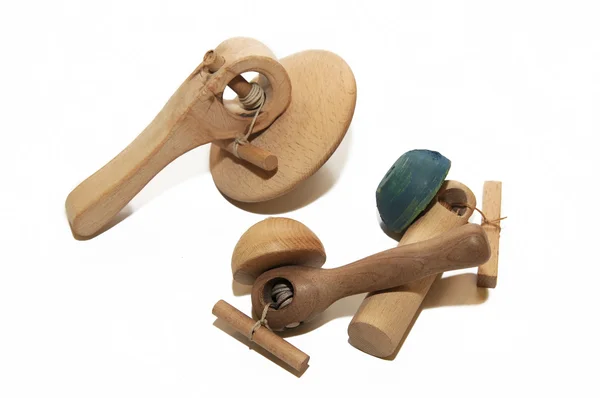Teetotum
Also found in: Thesaurus, Wikipedia.
- Name derived from earlier T totum (from the letter tee that appeared on one side of the toy), from totum, teetotum, from Latin totum, neuter sing. This object is a game piece used to simulate several common games & generate random numbers, letters, cards, dates, percentages & more.
- The word teetotum, which dates back to the 18th century, denotes a small four-sided disk or die having an initial letter inscribed on each of its sides, and a spindle passing down through it by which it could be twirled or spun with the fingers like a small top, the letter which lay uppermost, when it fell, deciding the fortune of the player.
- . A teetotum (or T-totum) is a form of gambling spinning top. A teetotum is a top spun with the fingers, rather than a whip or cord. A toy top spun with the fingers, formerly used in a game of chance. Form of top having usually 4, 6, 8, or 12 sides marked with distinctive symbols.
- A teetotum (or T-totum) is a form of gambling spinning top. It has a polygonal body marked with letters or numbers, which indicate the result of each spin.
tee·to·tum
Offering an outdoor pool, a restaurant and a furnished terrace, Teetotum hotel is located in Tulum. Free parking and free WiFi access in public areas are available. Each room here will provide you with air conditioning, a balcony and a refrigerator. Featuring a shower, private bathroom also comes with free toiletries.
(tē-tō′təm)n.teetotum
 (tiːˈtəʊtəm) n
(tiːˈtəʊtəm) ntee•to•tum
(tiˈtoʊ təm)n.

| Noun | 1. | teetotum - a conical child's plaything tapering to a steel point on which it can be made to spin; 'he got a bright red top and string for his birthday' spinning top, whirligig, top humming top - a top that makes a humming noise as it spins peg top - a pear-shaped top made of wood with a metal center pin plaything, toy - an artifact designed to be played with whip top, whipping top - a top that is spun by whipping |

Teetotum Definition
Want to thank TFD for its existence? Tell a friend about us, add a link to this page, or visit the webmaster's page for free fun content.Link to this page:
L’Enfant au toton (1738), by Jean-Siméon Chardin (1699-1779)
The word teetotum, which dates back to the 18th century, denotes a small four-sided disk or die having an initial letter inscribed on each of its sides, and a spindle passing down through it by which it could be twirled or spun with the fingers like a smalltop, the letter which lay uppermost, when it fell, deciding the fortune of the player.
The word was formed by prefixing to Latin totum, meaning the whole (stake), its initial T, which stood for it on one of the four sides of the toy, itself in earlier use called simply a totum and apparently first evoked, figuratively, by the Scottish poet and courtier William Dunbar (1460?-1530?) in To the King (Exces of thocht dois me mischeif):
He playis with totum and I with nychell [= with nothing].
The letters were originally the initials of the following Latin words: A for aufer, take away, D for depone, put down, N for nihil, nothing, and T for totum.
Subsequently they were the initials of English words, as the English engraver, artist, antiquary and writer Joseph Strutt (1749-1802) explained in The Sports and Pastimes of the People of England (1801):
The usage of the tee-totum may be considered as a kind of petty gambling, it being marked with a certain number of letters: and part of the stake is taken up, or an additional part put down, according as those letters lie uppermost. […] When I was a boy the tee-totum had only four sides, each of them marked with a letter; a T for take all; an H for half, that is of the stake; an N for nothing; and a P for put down, that is, a stake equal to that you put down at first. Toys of this kind are now made with many sides and letters.
IN FRENCH
The word for teetotum is toton, from the pronunciation of Latin totum, which was the earlier form, first attested in A Dictionarie of the French and English Tongues (1611), by Randle Cotgrave:
Totum. A kind of game with a whirlebone.
The form recorded in the first edition (1694) of the Ditionnaire de l’Académie française was totum, but it was specified that it was pronounced toton. Since the fourth edition (1762) of this dictionary, the recorded form has been toton.
Teetotum History
According to the Dictionnaire de la langue française (1872), by the French lexicographer Émile Littré (1801-81), in the French toton, the letters are A for Latin accipe, take, D for Latin da, give, R for French rien, nothing, and T for Latin totum.